Did you know a bird feeder can stay empty for weeks before birds find it? This fact shows the challenges people face in attracting birds to their feeders. Whether you’re new to bird feeding or experienced, knowing how to attract birds is key.
Many things can stop birds from visiting your feeder. These include predators, old seeds, and the wrong feeder placement. In this guide, we’ll cover common problems and solutions. We’ll also talk about how to make your backyard a bird-friendly place.
Key Takeaways
- It can take weeks or months for birds to find and trust a new feeder.
- Seed freshness, feeder cleanliness, and the right placement are vital for attracting birds.
- Predators and competition from natural food can keep birds away.
- Offering different feed types and keeping the supply fresh is crucial for success.
- Being patient and persistent is important for a thriving bird-feeding station.
Understanding Common Bird Feeding Challenges
Setting up a bird feeder is exciting, but it comes with challenges. From the start to dealing with environmental changes, bird lovers face many hurdles. These obstacles can make it hard for birds to visit your feeder.
Initial Setup Obstacles
Birds may be hesitant to use a new feeder. It can take 3-4 weeks for them to feel comfortable. The feeder’s visibility and location are also important. Feeders in wooded areas are noticed faster than those in open spaces.
Bird Behavior Basics
Knowing how birds behave helps solve feeding challenges. Birds find food by sight and are cautious of new things. They prefer safe spots to eat, like areas with cover or clear views.
Environmental Factors
The type of habitat around your feeder affects bird visits. Climate change, habitat loss, and natural food availability can change bird numbers and types. For example, a mild fall might mean fewer birds need feeders. But harsh winters make feeders crucial for survival.
“Birds locate food by sight and can take 3-4 weeks to start using a new feeder.”
To overcome these challenges, understand bird behavior and adapt to your environment. By doing so, you can attract more birds to your yard. This makes bird feeding a rewarding experience.
Predator Presence: A Major Deterrent
Predators like raccoons, squirrels, cats, and birds of prey can scare away smaller birds. Birds are very cautious and won’t visit feeders if they feel unsafe.
Outdoor cats kill over 1 million birds each year in the U.S. To keep birds safe, place feeders high up and far from trees or shrubs. This gives birds a safe place to land and feel secure.
- Use reflective bird scare tape to confuse birds and animals. It shines brightly and makes a noise when it moves.
- Install solar-powered LED lights to scare away predators. They flash like a big predator’s eyes.
- Try owl decoys or netting to keep small animals away from feeders.
Using these predator deterrents can make your feeders safer for birds. This creates a welcoming spot for birds to visit and stay.
| Predator Deterrent Product | Price Range |
|---|---|
| Reflective Bird Scare Tape | $9.97 – $14.99 |
| Predator Guard Solar LED Deterrent Light | $19.99 – $29.99 |
“Observing dominance behaviors such as displacement, threat displays, and appeasement among birds can offer insights into social structures and interactions within feeders.”
Predators can change how birds act and interact at feeders. Knowing this and making your feeders safe can help more birds visit.
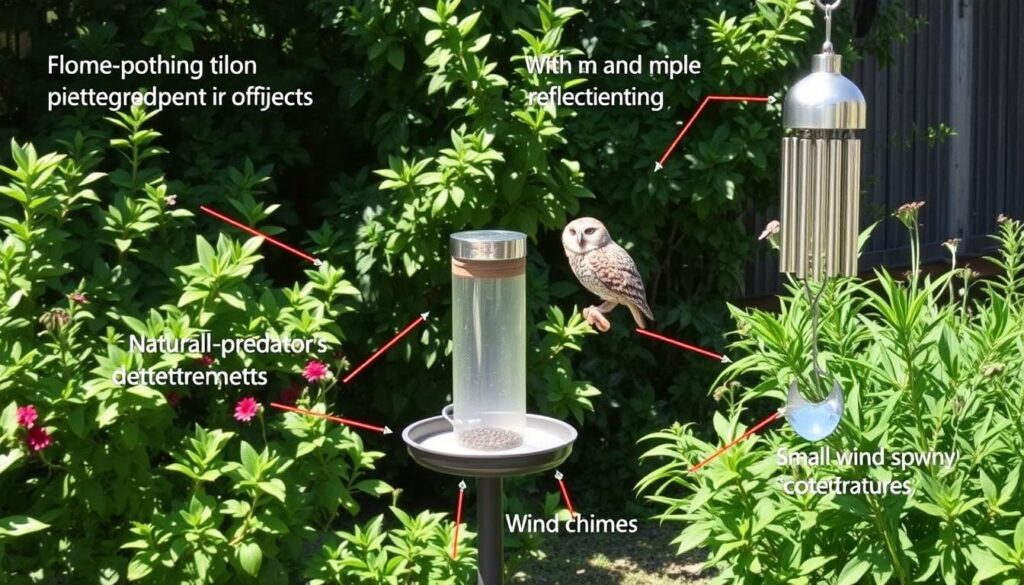
Strategic Feeder Placement for Maximum Bird Traffic
Proper feeder placement is key to attracting birds and keeping them safe. By placing your feeders wisely, you can make your yard a welcoming spot for birds. Here are some tips to help you attract more birds to your feeders.
Distance from Shelters
Put your feeders 10 to 12 feet away from natural shelters like trees or shrubs. This distance lets birds easily get to the feeders and find a safe spot if needed. Make sure feeders are not too close to windows to avoid bird collisions. Sadly, 150 million birds die from window strikes each year in the U.S.
Height Considerations
Change the heights of your feeders to suit different bird types. Smaller birds like chickadees and finches like feeders 4 to 6 feet high. Larger birds, like jays, prefer feeders at 6 to 8 feet. Ground feeders need to be under a covered area to stay safe.
Safe Zone Creation
Creating a safe feeding zone is crucial. Keep feeders at least 10 feet from predators like cats. Use window screens or ribbons to stop bird collisions. Also, clean windows to avoid confusing birds.
By following these tips, you can make your yard a bird paradise. A well-planned feeder system is essential for attracting birds and keeping them safe.
Why Won’t Birds Come to My Feeder?
If you’ve set up a bird feeder but few birds visit, you’re not alone. There are many reasons why birds might not come to your feeder. But, with some troubleshooting, you can attract more birds and enjoy their presence.
One big reason could be the quality and freshness of your bird seed. Birds don’t like stale or wet seed. Make sure you use high-quality seed and keep it fresh.
- Regularly check the seed in your feeder and refill it as needed to keep the supply fresh and plentiful.
- Consider switching to a different seed type, as birds may prefer certain varieties over others, depending on the season and their dietary needs.
Another thing to think about is where you put your feeder. Birds like to have cover nearby, like trees or shrubs, for safety. But, if your feeder is too close, birds might not see it.
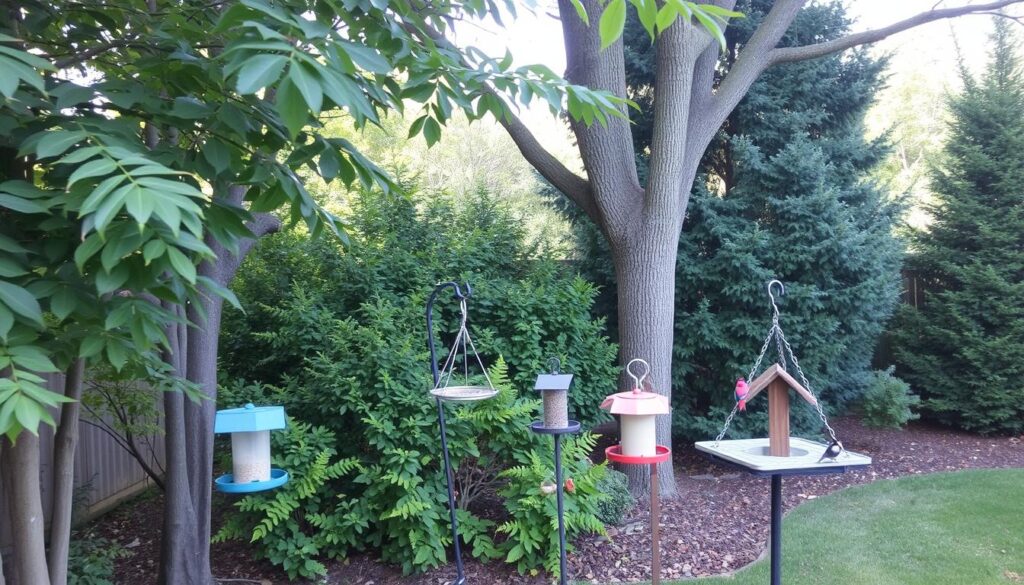
Also, unwanted visitors like squirrels or larger birds can scare away smaller birds. Keep your feeder clean to prevent mold or bacteria. This will make birds feel safer to visit.
“The key to attracting birds to your feeder is to create a safe, inviting, and consistent food source. With a little patience and the right adjustments, you can turn your backyard into a vibrant avian hub.”
By fixing these common bird feeding problems, you can attract many different birds to your backyard. And you’ll get to enjoy their beauty.
Selecting the Right Bird Feed Types
Choosing the right bird seed is key to attracting different birds to your feeder. High-quality, nutrient-rich seeds meet the varied needs of birds. Let’s look at some premium seed options and how they affect seasonal feeding.
Premium Seed Options
Black oil sunflower seeds are a top choice, attracting many bird species. Safflower seeds, with their thick shells, are loved by cardinals and chickadees. Nyjer or thistle seeds are a hit with small finches like American Goldfinches.
Peanuts and suet also attract various birds, including woodpeckers and nuthatches. But, keep these foods dry to avoid aflatoxin risks.
Seasonal Feed Changes
As seasons change, birds’ needs shift. In cold months, they seek high-energy foods like black oil sunflower seeds. In warmer months, they prefer insects and natural foods.
Adjusting your bird seed selection to seasonal changes ensures a year-round supply of premium bird food. This keeps your backyard birds well-fed and happy.
| Seed Type | Preferred Bird Species |
|---|---|
| Black Oil Sunflower Seeds | Grosbeaks, Sparrows, Juncos, Towhees, Jays, Quail |
| Safflower Seeds | Cardinals, Chickadees, Native Sparrows |
| Nyjer/Thistle Seeds | American Goldfinches, Pine Siskins, Indigo Buntings |
| Peanuts | Woodpeckers, Nuthatches, Jays |
| Suet | Woodpeckers, Nuthatches, Chickadees, Starlings, Jays |
Maintaining Fresh and Clean Feed Supply
It’s key to keep your bird feeders full of fresh bird seed to attract and feed your birds. Store your bird seed in airtight containers. Buy only what you can use in 4-6 weeks. Sun and humidity can spoil seed fast, so change the seed in your feeders every 1-2 weeks.
After it rains, check your feeders for wet seed and replace it right away. Wet seed can grow mold, which is bad for birds. Keeping your feeders and seed clean will make your backyard a favorite spot for birds.
- Store bird seed in airtight containers to preserve freshness
- Purchase only the amount of seed you can use within 4-6 weeks
- Replace seed in feeders every 1-2 weeks to prevent spoilage
- Check for and replace any wet seed after rain to prevent mold growth
- Regularly maintain clean bird feeders to ensure a healthy feeding environment
By following these steps, you’ll create a lively backyard bird habitat. Keeping a steady supply of fresh and clean bird seed is essential. It ensures your birds stay happy and well-fed.
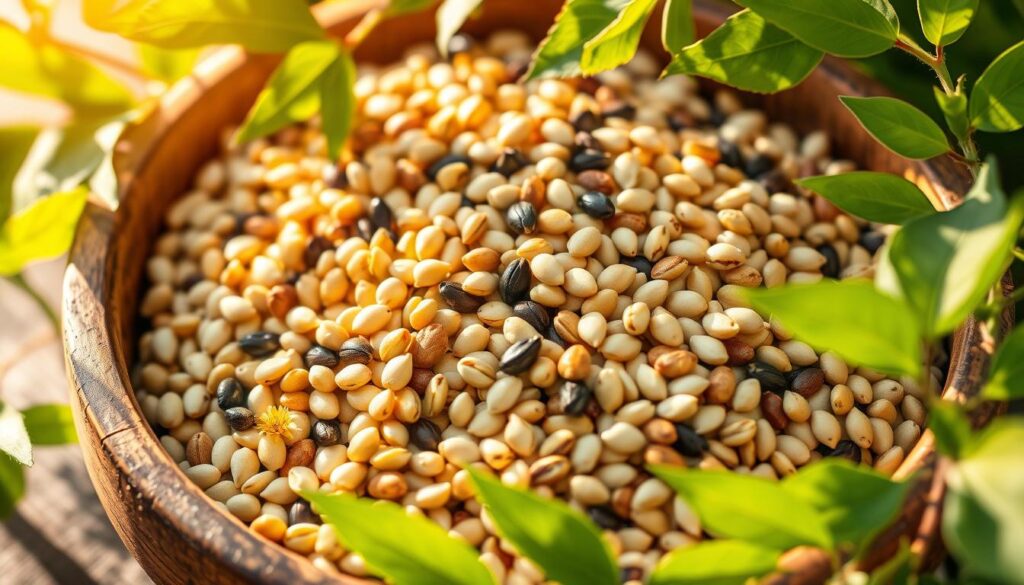
The Impact of Weather on Bird Feeding
The weather greatly affects how birds use feeders all year. As seasons change, birds may need more or less food from feeders. This means we need to adjust how we feed them to keep food coming.
Seasonal Variations
In the fall, birds often find enough food outside and visit feeders less. But when winter comes and food is scarce, they need feeders more. In really cold or snowy weather, feeders are crucial for their survival.
Summer can also be tough, especially with rain and heat. These conditions can spoil the seed in feeders. We must clean and refill feeders often to keep the seed fresh and safe for birds.
Weather Protection Strategies
- Use rain guards or baffles to keep seed dry and prevent spoilage.
- Choose all-weather feeders to ensure birds have food no matter the weather.
- Make sure feeders drain well to avoid water buildup and mold.
- Keep bird seed in airtight containers to keep it fresh, especially in summer.
By knowing how weather affects bird feeding and using the right strategies, we can help our feathered friends all year.
| Season | Weather Impact | Recommended Strategies |
|---|---|---|
| Fall | Reduced feeder visits due to natural food abundance | Offer a variety of seed types to encourage consistent visits |
| Winter | Increased reliance on feeders due to scarce natural food sources | Provide high-energy foods and ensure feeders are protected from harsh conditions |
| Summer | Seed spoilage risk from rain, heat, and humidity | Use weather-resistant feeders, enhance drainage, and store seed properly |
By understanding seasonal changes and using the right feeding strategies, we can make sure our bird friends have food all year.
Creating a Bird-Friendly Garden Environment
Turn your garden into a lively bird haven by adding native plants. These plants offer food and shelter for birds. Mix trees, shrubs, and ground cover to attract many bird species. Also, provide water sources like birdbaths or ponds for their drinking needs.
Using fewer pesticides is key to protect birds and their food. This helps keep the garden healthy and inviting for birds.
The Merlin Bird ID app by Cornell Labs has found 71 bird species in this garden. Over 30 California quails live here, making it a bird paradise. Clean bird feeders with a bleach solution every couple of weeks. Having multiple feeders can also help reduce bird competition.
Place bird feeders 5 to 6 feet off the ground to keep pests away. Clean up spilled birdseed to prevent rodents. Plant a variety of plants to attract birds all year. Use physical barriers instead of harmful pesticides for pest control.
A bird-friendly garden helps local birds and supports conservation. It also reduces stress and connects people with nature. By feeding and gardening for birds, you can make your backyard a lively habitat for them.
| Statistic | Value |
|---|---|
| Number of bird species identified in the garden | 71 |
| Number of California quails in the covey | Over 30 |
| Recommended bird feeder cleaning frequency | Every couple of weeks |
| Recommended minimum height for bird feeders | 5-6 feet above the ground |

“Creating a bird-friendly environment in the yard can lead to reduced stress and increased connection with nature for people of all ages.”
Proper Feeder Maintenance and Cleaning
Keeping your bird feeder clean is key to attracting birds. It makes your backyard a welcoming place for them. It also stops diseases from spreading among the birds.
Cleaning Schedule
Experts say clean bird feeders at least once a month. Clean them more often in warm, humid weather. This is when bacteria and mold grow fast.
Cleaning every two weeks is best for seed and suet feeders. Hummingbird feeders need cleaning every few days. This stops the sugar solution from getting cloudy and bad.
Maintenance Tips
- Use a mild soap solution and rinse well. Make sure the feeder is dry before you fill it again.
- Check feeders often for damage or wear. Replace parts as needed to keep them strong.
- Soak the feeder in a diluted bleach solution for 10 minutes. This sanitizes it well.
- Clear the ground under the feeder of leftover feed. This keeps away unwanted visitors and stops disease spread.
- Always wash your hands with soap and water after handling bird feeders.
Good feeder care keeps your backyard birds healthy. It also makes sure they keep coming back. By following these easy steps, you can enjoy bird watching for many years.
Natural Food Sources Competition
As the seasons change, birds may find themselves drawn to natural food sources rather than your feeder. During warmer months, birds often prefer seeking out insects, fruits, and seeds from native plants. This can lead to a decline in feeder activity. To keep your backyard birds coming back, it’s essential to adapt your feeding strategy to complement these natural food sources.
One effective approach is to offer specialty items like mealworms or fresh fruit alongside your standard seed blend. These unique offerings can pique the interest of your feathered friends, even when natural food is plentiful. Additionally, consider providing a variety of feed types, as different bird species have distinct dietary preferences.
- Offer a mix of premium natural bird food options to attract a wider range of species.
- Adjust your seasonal feeding patterns to account for the availability of food competition from natural sources.
- Introduce specialty items like mealworms or fruit to supplement your standard seed blend.
By understanding the impact of natural food sources on bird behavior and adapting your feeding strategy accordingly, you can maintain a thriving backyard bird population throughout the year. With patience and a keen eye for their preferences, you’ll be able to create a welcoming environment that keeps your feathered friends coming back, even when nature’s bounty is at its peak.

“By offering a diverse array of food options, you can ensure that your backyard birds have access to the sustenance they need, even when natural sources are abundant.”
The Importance of Water Sources
Having a reliable water source is key to attracting birds to your backyard. Birds need clean, fresh water for drinking and bathing, especially when it’s hot. By adding birdbaths and other water features, you can make your garden a welcoming spot for many bird species.
Birdbath Placement
When placing a birdbath, find a spot that’s easy for birds to get to but safe from predators. It should be near trees or shrubs, within 10-20 feet. The birdbath should be 1 to 3 inches deep to prevent drowning. Choose heavy-duty plastic birdbaths to avoid cracking in cold weather.
Water Maintenance
It’s important to keep the birdbath water clean and fresh. Clean it every 2-4 days to stop algae and debris from building up. Adding a dripper or mister can make the water more appealing to birds. In cold areas, a heated birdbath ensures water stays unfrozen for birds all winter.
By focusing on water sources and keeping them clean, you can turn your backyard into a bird paradise. This will attract a wide variety of birds all year long.
| Feature | Recommendation |
|---|---|
| Depth | 1-3 inches |
| Material | Heavy-duty plastic |
| Cleaning Frequency | Every 2-4 days |
| Water Movement | Dripper or mister |
| Winter Heating | Heated birdbath |
“Providing a reliable water source is a crucial element in attracting and supporting birds in your backyard.”
Dealing with Unwanted Visitors
Backyard birding is a fun hobby, but it can get frustrating when squirrels and aggressive birds show up. They can eat all your bird feed, scare away the birds you want, and make a mess. But, with the right steps, you can keep your backyard bird sanctuary clean and full of life.
Squirrels are a big problem for many bird feeders. They can jump high to get to your feeders. To stop them, try squirrel-proof feeders or baffles on your feeders. You can also give squirrels their own feeders with safflower seeds, which they don’t like as much.
Aggressive birds like European starlings, grackles, and crows can also be a problem. They can take over your feeders, pushing out smaller birds and using up all your bird seed. Use wire cage feeders to keep them out. Tray feeders that catch seeds can also keep pigeons away by denying them spilled seeds.
| Unwanted Visitor | Deterrent Strategies |
|---|---|
| Squirrels |
|
| Aggressive Bird Species (e.g., European starlings, grackles, crows) |
|
By using these strategies, you can keep your backyard bird community happy and healthy. Keep an eye on your feeders and change your plan if needed. This way, your birds can enjoy a safe and plentiful feeding spot.
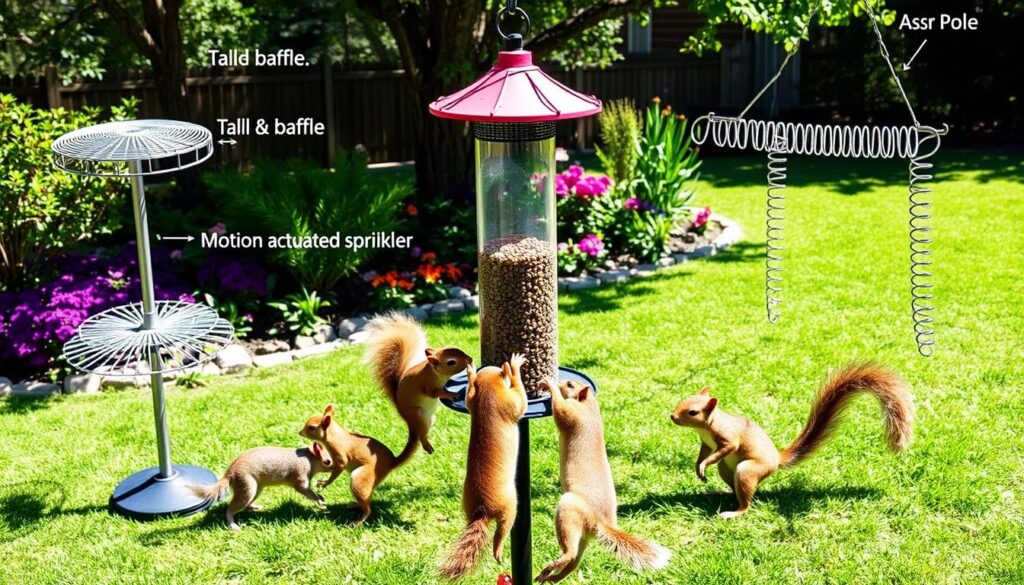
Patience and Persistence in Bird Attraction
Attracting birds to a new feeder takes time and effort. It might take weeks or months for them to find and trust the new food. Keeping your feeder full and consistent helps birds get into a routine and visit your backyard often.
Building Trust
Start by adding a little bird-friendly seed to your feeder. As birds start to visit, you can add more seed. This slow increase helps build trust with the birds, making them feel safe in your yard.
Establishing Patterns
Being consistent is important for bird attraction tips. Always keep your feeders full and clean. Birds like knowing what to expect, and they’ll come to rely on your bird feeding schedule. With time and effort, more birds will visit your yard.
Remember, patience and persistence are key for bird trust and attraction. By making your yard safe and welcoming, and keeping a regular feeding schedule, you’ll attract a loyal group of birds.
“The greatest reward in creating a bird-friendly garden is the joy of viewing the visitors it attracts.” – Stephen Buchmann
Common Feeder Problems and Solutions
As avid bird enthusiasts, we often face challenges with our bird feeders. Issues like seed blockages, feeder damage, and design flaws are common. It’s important to solve these problems to keep our bird-feeding experience enjoyable.
One big problem is when seed gets clogged in the feeder. This stops birds from getting their food. It might happen if you use the wrong seed or fill the feeder too much. To fix this, make sure the seed moves easily. Try using bigger seeds like black-oil or striped sunflower, which birds like more.
Feeder damage or wear and tear is another issue. It can make the feeder unsafe for birds. Check your feeders often and fix or replace them if needed. If a feeder isn’t attracting birds, try a different design or a new spot.
FAQ
Why won’t birds come to my feeder?
Birds might not visit your feeder for many reasons. These include predators, stale food, noise, or competition with natural food. To attract birds, place feeders well, keep them clean, and be patient.
Why do new feeders take time to attract birds?
It can take weeks or months for birds to find and trust a new feeder. The type of habitat, seed freshness, and how clean the feeder is also matter.
How do predators affect bird visitation to feeders?
Predators like raccoons and cats scare off smaller birds. Birds choose safe spots to eat. Make sure your feeders are safe from predators.
Where should I place my bird feeder?
Put feeders at different heights to attract various birds. They should be close to trees or shrubs for safety. This helps birds escape from predators.
What are common reasons for birds not visiting my feeder?
Birds might not visit if the seed is stale or wet. New or dirty feeders also scare them off. Predators, too much seed, and natural food can also keep them away.
What types of bird seed should I use?
Use high-quality seeds like black oil sunflower seeds and safflower. Avoid cheap mixes that songbirds don’t like.
How do I keep bird seed fresh?
Store seed in airtight containers and buy only what you’ll use in 4-6 weeks. Replace seed in feeders every 1-2 weeks. Check for wet seed after rain to prevent mold.
How does weather affect bird feeding patterns?
Weather changes how birds eat. In fall, they eat less from feeders. In winter, they rely on feeders more. Keep feeders dry and offer different foods for each season.
How can I make my garden more bird-friendly?
Plant native species for food and shelter. Add trees, shrubs, and ground cover. Offer water and use fewer pesticides.
How often should I clean my bird feeders?
Clean feeders at least once a month to stop disease. Use soap and water, then dry them well before refilling. Check for damage and replace parts as needed.
Why do birds prefer natural food sources over my feeder?
Birds like natural food, especially in warmer months. Offer foods that go with natural sources, like mealworms or fruit.
How important is a water source for attracting birds?
Water is key for attracting birds, especially in hot weather. Place birdbaths near feeders but not where predators can hide. Keep water clean and fresh, and add movement with drippers or misters.
How can I deter unwanted visitors like squirrels?
Squirrels can scare birds away and eat a lot of seed. Use squirrel-proof feeders or baffles. Offer squirrel food away from bird feeders and use seeds squirrels don’t like, like safflower.
How long does it take for birds to get used to a new feeder?
It takes patience to attract birds to a new feeder. It can take weeks or months. Keep feeding patterns consistent and increase seed amounts as birds visit more.
What are some common feeder problems and how can I address them?
Fix problems like seed blockages and feeder damage. Make sure seed flows well and is easy for birds to get. Check for sharp edges or unstable parts. Watch for sick birds and take steps to stop disease spread.
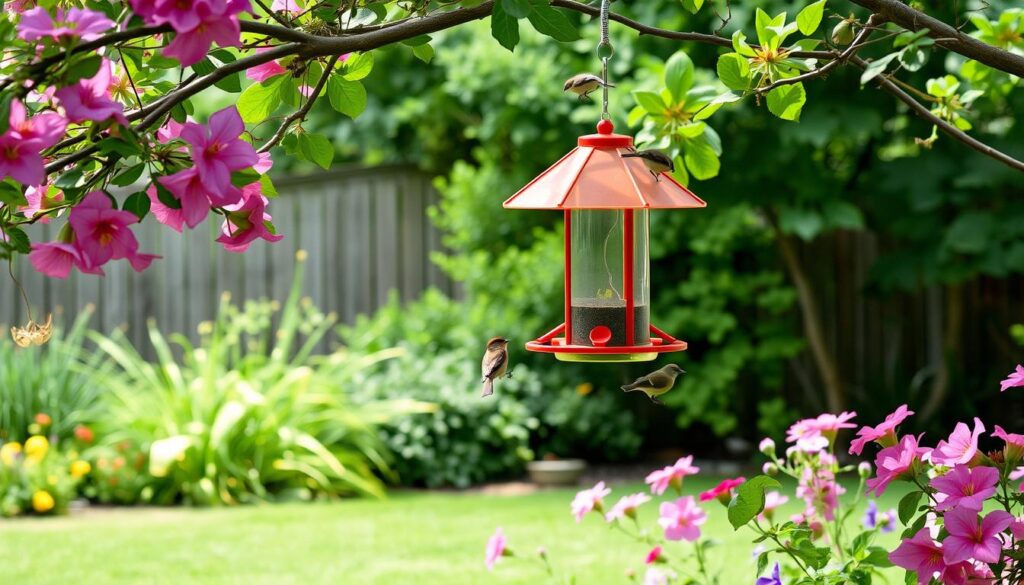

биржа аккаунтов платформа для покупки аккаунтов
услуги по продаже аккаунтов купить аккаунт с прокачкой
услуги по продаже аккаунтов профиль с подписчиками
заработок на аккаунтах платформа для покупки аккаунтов
маркетплейс аккаунтов соцсетей магазин аккаунтов
маркетплейс аккаунтов биржа аккаунтов
продажа аккаунтов площадка для продажи аккаунтов
услуги по продаже аккаунтов перепродажа аккаунтов
маркетплейс аккаунтов соцсетей магазин аккаунтов социальных сетей
маркетплейс аккаунтов купить аккаунт с прокачкой
маркетплейс аккаунтов https://ploshadka-prodazha-akkauntov.ru/
купить аккаунт с прокачкой маркетплейс аккаунтов
аккаунты с балансом https://kupit-akkaunt-top.ru/
платформа для покупки аккаунтов маркетплейс аккаунтов
Account Acquisition Online Account Store
Online Account Store accountsmarketplacepro.com
Account Sale Account market
Account Selling Platform Account trading platform
Account Selling Platform Accounts market
Sell Pre-made Account https://socialaccountsstore.com/
Profitable Account Sales Profitable Account Sales
Sell Account Buy and Sell Accounts
Social media account marketplace Sell Pre-made Account
Account Buying Service Marketplace for Ready-Made Accounts
Find Accounts for Sale Account Buying Service
account market account store
ready-made accounts for sale accounts market
accounts for sale profitable account sales
buy and sell accounts account selling platform
account store account catalog
buy account account market
secure account sales buy and sell accounts
accounts for sale account trading platform
account trading service account trading platform
secure account purchasing platform online account store
account purchase account marketplace
online account store https://buy-soc-accounts.org
buy account guaranteed accounts
ready-made accounts for sale account marketplace
account purchase gaming account marketplace
accounts market account market
find accounts for sale sell pre-made account
accounts market account market
account catalog account market
account purchase social media account marketplace
find accounts for sale buy and sell accounts
accounts market account sale
find accounts for sale account selling service
secure account purchasing platform verified accounts for sale
account market buy pre-made account
account exchange service account purchase
account buying platform https://accounts-buy-now.org
online account store sell accounts
account market https://accounts-offer.org
buy accounts https://accounts-marketplace.xyz
sell accounts accounts market
accounts marketplace https://accounts-marketplace.live/
marketplace for ready-made accounts accounts market
sell pre-made account buy-accounts.space
ready-made accounts for sale https://buy-accounts-shop.pro/
buy accounts https://social-accounts-marketplace.live
online account store https://buy-accounts.live/
verified accounts for sale https://accounts-marketplace.online/
account purchase https://accounts-marketplace-best.pro
площадка для продажи аккаунтов https://akkaunty-na-prodazhu.pro/
маркетплейс аккаунтов магазины аккаунтов
продать аккаунт https://kupit-akkaunt.xyz/
магазин аккаунтов akkaunt-magazin.online
биржа аккаунтов https://akkaunty-market.live
продажа аккаунтов kupit-akkaunty-market.xyz
магазин аккаунтов магазины аккаунтов
площадка для продажи аккаунтов online-akkaunty-magazin.xyz
площадка для продажи аккаунтов akkaunty-dlya-prodazhi.pro
биржа аккаунтов https://kupit-akkaunt.online/
facebook ad account buy buying facebook accounts
facebook accounts for sale https://buy-ad-accounts.click
facebook ad account for sale https://buy-ad-account.top/
buy ad account facebook https://buy-ads-account.click
facebook ad account buy https://ad-account-buy.top
buy facebook ad account buy fb ad account
buy facebook ads manager facebook ad account for sale
buying facebook ad account https://buy-ad-account.click/
buy facebook accounts cheap https://ad-accounts-for-sale.work
google ads account seller https://buy-ads-account.top
buy adwords account https://buy-ads-accounts.click
buy facebook advertising https://buy-accounts.click
old google ads account for sale buy google ads account
buy google ads threshold accounts https://ads-account-buy.work/
google ads accounts for sale https://buy-ads-invoice-account.top
google ads reseller buy google agency account
sell google ads account https://buy-ads-agency-account.top
google ads account buy https://sell-ads-account.click